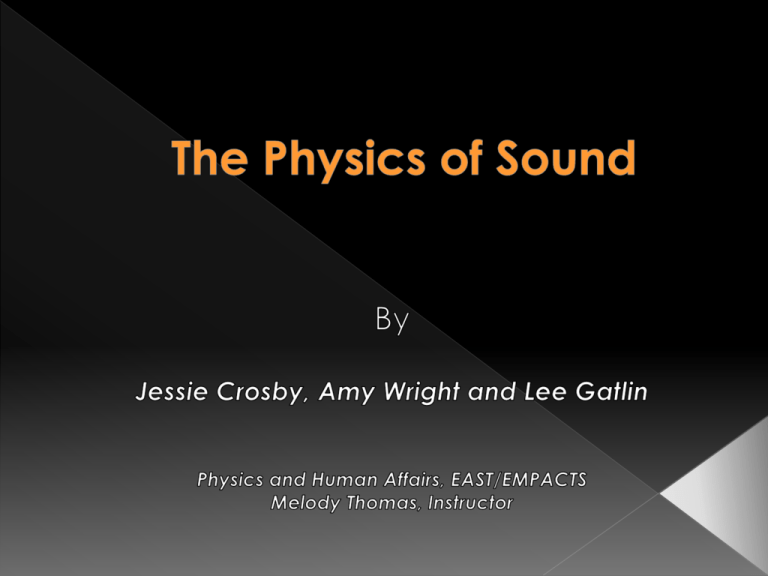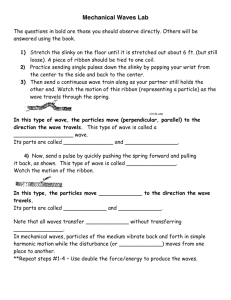Sound - NWACC - Faculty Web Pages
advertisement

Curriculum Frameworks for grades 3 and 4 include physics concepts relating to sound and wave motion. These concepts are also included in the college science curriculum. Students from the Physics and Human Affairs class at NWACC developed hands on activities for fourth grade students at NorthSide Elementary School in Rogers, AR. PS.6.3.1 › Identify characteristics of wave motion: › amplitude › Frequency PS.6.3.2 › Investigate the relationship between sound and wave motion PS.6.3.3 › Determine the impact of the following variables on pitch: › length › mass › tension › state of matter The goal of this EAST project was to learn the Physics of Sound through developing course material for an elementary class setting. To collaborate with an area school and provide an outreach experience. Contacted the school principal and assessed need. Collaborated with Mr. Tuttle, 4th grade teacher, and Melody Thomas, college physics instructor, to determine the framework science curriculum needs for both classes. Coordinated with Mr. Tuttle in development and implementation of hands on activities. We went to Northside Elementary and taught fourth grade class the physics behind sound. Used power point show to focus students and augment classroom instruction. Provided four separate lab activities and one class demonstration. Had teacher led, class discussion with quiz. http://media-2.web.britannica.com/eb-media/20/4320-004-CFE3C8FE.gif The definition of sound is the sensation produced by stimulation of the organs of hearing by vibrations transmitted through the air or other medium. http://www.privateline.com/TelephoneHistor y/speech.jpg Wavelength Crest-the highest part of the wave Frequency -of a wave refers to how often the particles of the medium vibrate when a wave passes through the medium. Amplitude-is the height of a wave Pitch-tone of a sound wave that is determined by its frequency, which is the wavelength divided by the speed of sound. Wave-can be described as a disturbance that travels through a medium A. Amplitude- of a wave refers to the maximum amount of displacement of a particle on the medium from its rest position. B. crest of a wave is the point on the medium which exhibits the maximum amount of positive or upwards displacement from the rest position. C. Trough of a wave is the point on the medium which exhibits the maximum amount of negative or downwards displacement from the rest position. The one of the top has shorter wavelengths creating a higher frequency Wavelengths are measured The bottom wave has longer wave lengths giving it a lower frequency We also wanted to work to achieve a interactive and fun educational environment http://projects.kaboom.org/Portals/630/performing.jpg We did this by using a number of demonstrations and lab activities for kids to participate in. 1. Using rubber bands we were able to give the students a better perspective on the vibrations involve with sound. http://itsi.concord.org/artwork/Teemss2_images/Units/u01_i02/rubberBandsBox/u01_i02_web_rubberBandsBox.png 2.Using a ruler and a marker we were able to give students a more visual representation of Sound waves. 3.Using balloons we gave students a visual presentation of how we use vocal chords and are able to make sound. 4. By having the students listen to different sounds material items being dropped on a desk, by having them put their ears to the desk while the item was dropped. We used a slinky to demonstrate the movement of sound waves and waves over all. 1. Hypothesize what happens to sound waves when they reach a wall or other solid, flat object. 2. If sound can’t travel in space, hypothesize what other modes of communication astronauts can use when they are outside the space shuttle? 3.Explain why, based on the behavior of sound waves, a classroom with a tile floor is louder than a library that is carpeted. 4. How does sound travel when you have a conversation with your friends? 5. Think about what it is like to hear things under water. Debate whether sound travels better in liquids (like water), gases (air), or solids (like putting your head down on a desk and having someone slam a book down on the surface)? 6. Discuss why you see lightning before you hear thunder during storms. Microsoft Office: Word, Power Point and Front Page Educational Technology – Overhead projector, computers, flash drives, internet, laptops Amy Wright – school contact, final power production, course content research Jesse Crosby – assisted in hands on activities with children, gathered materials for activities Lee Gatlin – researched instructional materials and assisted in development of activities and assisted in draft of final paper http://www.glenbrook.k12.il.us/gbssci/phys/Class/s ound/u11l1a.html http://id.mind.net/~zona/mstm/physics/waves/intr oduction/introductionWaves.html http://wow.osu.edu/experiments/sound/slinky.html http://school.discoveryeducation.com/lessonplans /programs/soundwaves/ http://www.privateline.com/TelephoneHistory/spe ech.jpg http://www.geo.mtu.edu/UPSeis/images/Swave_slinky.gif Administration, Faculty and students of Northside Elementary School, Rogers, AR Mr. Tuttle, 4th grade teacher, Northside Elementary School, Rogers, AR Mrs. Melody Thomas, PHA Instructor, NWACC C. Dianne Phillips, EAST/EMPACTS Facilitator, NWACC






